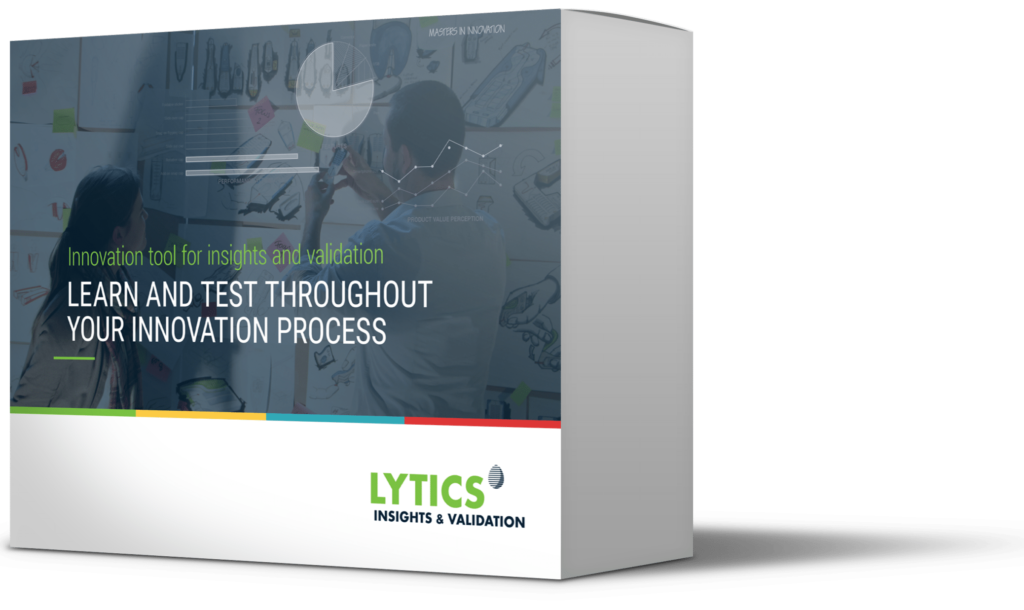We provide creative services to conceptualize and pretotype your new product, your new service or your innovative business model. To be more specific, we validate and iteratively sharpen your value proposition.
Our Lytics suite of algorithms and services get you going at once
Our strategic designers developed a unique knowledge in the pretotyping process creating low-cost, low-risk prototypes in order to quickly test and validate product ideas before investing significant resources in building the actual product. The benefit of pretotyping is that it can help businesses identify and address potential issues with a new value proposition early on, before investing significant time and money in the development process. Pretotyping is used by our product designers to test products, by our service designers to test service attributes and by our business engineers to validate pricing and business model attributes.
This highly creative process encompasses multiple advantages. First of all it provides substantial cost savings. By creating low-cost prototypes and testing them early in the development process, businesses can avoid spending significant resources on products that may not be successful in the market. Secondly it saves time because it allows businesses to test product ideas quickly and efficiently, identifying potential issues and making improvements in a shorter amount of time.
Our teams are therefore capable of guiding product development teams in better decision-making. Teams can make informed data-driven decisions about product development by providing real-world feedback on potential product ideas. Moreover, it leads to improved product quality by delivering value propositions that better meet the needs and preferences of customers.
Learning by experimentation put into practice
The pretotyping process encourages experimentation in both consumer and B2B contexts. It’s being flanked with our Lytics platform to establish data-driven decisions based upon user feedback to understand your real value drivers and sharpen your product concept. These services provide you with the insights and statistical data to direct and redirect your innovation program from idea to product launch.
Several new online techniques can help validate consumers’ willingness to buy and willingness to pay for new products and services. Some of these techniques include:
Crowdfunding campaigns
Crowdfunding platforms like Kickstarter or Indiegogo allow businesses to gauge consumer interest in a product or service by soliciting pre-orders or pledges to fund the project.
Landing pages
Creating a landing page for a new product or service can help businesses collect email addresses and other contact information from interested consumers, allowing them to follow up and gauge their willingness to buy.
Surveys
Online surveys can help businesses collect feedback on product ideas, pricing, and other important factors that can impact consumers’ willingness to buy and pay.
A/B testing
A/B testing involves creating two versions of a product or service and testing them with different audiences to see which one is more appealing and likely to generate sales.
The value of these online techniques lies in their ability to help businesses save time and money in the product development process. By validating consumer interest and willingness to pay early on, businesses can avoid investing in products or services that may not be successful, and focus their efforts on ideas with greater potential for success. Additionally, these techniques can help businesses better understand their target audience and create products that meet their needs and preferences, ultimately leading to more successful launches and stronger customer relationships.
We model adoption and rejection of innovation
To help businesses to model and analyze Verhaert has invested tremendously in several techniques, for instance conjoint analysis. Conjoint analysis is a statistical technique that helps businesses determine how consumers value different product attributes such as price, quality, and features. It works by presenting consumers with different product profiles that vary in terms of their attributes and then asking them to indicate which product they would be most likely to purchase. Through statistical analysis of the data collected, businesses can determine how different attributes impact consumer willingness to buy and pay, and use this information to develop more successful products and pricing strategies.
Other algorithms that may be used to analyze data collected from online techniques include machine learning algorithms and regression analysis. These algorithms can help identify patterns and correlations in the data that may not be immediately apparent and can be used to create predictive models that estimate consumer behavior and market demand for new products and services. Overall, the use of algorithms can help businesses make data-driven decisions about product development and pricing, leading to greater success and profitability in the marketplace.
Pretotype your product or service idea
Book your introduction to the Lytics pretotyping toolbox and get started with Strategic Innovation.
Why?
- Mitigate your risks
- Sharpen your ideas
- Learn more fast





